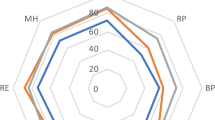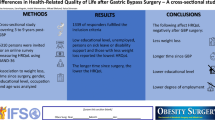Abstract
Background
A substantial proportion of severely obese patients undergoing bariatric surgery have not developed disease as a consequence of obesity. Little is known about the effects of bariatric surgery on health-related quality of life (HRQL) in this patient group. In a prospective study at a public hospital, we compared HRQL in gastric bypass patients with and without obesity-related disease before and 2 years after surgery.
Methods
HRQL was assessed in 232 severely obese patients before, 1 year, and 2 years after Roux-en-Y gastric bypass. We used a general HRQL questionnaire, the Short Form 36, and an obesity-specific questionnaire, the Obesity-related Problems scale. The patients were divided into two groups based on the presence of obesity-related disease (n = 146) or not (n = 86) before surgery. We defined obesity-related disease as having at least one of the following conditions: type 2 diabetes mellitus, hypertension, dyslipidemia, coronary heart disease, obstructive sleep apnea, gastroesophageal reflux disease, or osteoarthritis. Linear mixed models were used to analyze the HRQL outcomes.
Results
Before surgery, patients with no obesity-related disease reported equal HRQL compared with patients with obesity-related disease. Two years after gastric bypass, substantial improvements in all subscales of Short Form 36 and in Obesity-related Problems scale were observed in both groups, and the improvements were similar in 7 out of 8 subscales of Short Form 36 as well as for the Obesity-related Problems scale.
Conclusions
Baseline HRQL was similar in patients with and without obesity-related disease prior to gastric bypass. After surgery, patients with no comorbidity had similar positive changes in HRQL as patients with one or several comorbidities. These findings indicate that other factors than obesity-related disease are at least as important for severely obese patients’ impaired HRQL.


Similar content being viewed by others
References
Doll HA, Petersen SE, Stewart-Brown SL. Obesity and physical and emotional well-being: associations between body mass index, chronic illness, and the physical and mental components of the SF-36 questionnaire. Obes Res. 2000;8(2):160–70.
Sullivan M, Karlsson J, Sjostrom L, et al. Swedish obese subjects (SOS)—an intervention study of obesity. Baseline evaluation of health and psychosocial functioning in the first 1743 subjects examined. Int J Obes Relat Metab Disord. 1993;17(9):503–12.
Kolotkin RL, Meter K, Williams GR. Quality of life and obesity. Obes Rev. 2001;2(4):219–29.
Adams TD, Davidson LE, Litwin SE, et al. Health benefits of gastric bypass surgery after 6 years. JAMA. 2012;308(11):1122–31.
Ahmad A, Laverty AA, Aasheim E, et al. Eligibility for bariatric surgery among adults in England: analysis of a national cross-sectional survey. JRSM Open. 2014;5(1):2042533313512479.
Sharma AM, Kushner RF. A proposed clinical staging system for obesity. Int J Obes Lond. 2009;33(3):289–95.
Gill RS, Karmali S, Sharma AM. The potential role of the Edmonton obesity staging system in determining indications for bariatric surgery. Obes Surg. 2011;21(12):1947–9.
Livingston EH. Pitfalls in using BMI as a selection criterion for bariatric surgery. Curr Opin Endocrinol Diabetes Obes. 2012;19(5):347–51.
Dimick JB, Birkmeyer NJ. Rethinking eligibility criteria for bariatric surgery. JAMA. 2014;312(9):953–4.
Jakobsen GS, Hofso D, Roislien J, et al. Morbidly obese patients—who undergoes bariatric surgery? Obes Surg. 2010;20(8):1142–8.
Libeton M, Dixon JB, Laurie C, et al. Patient motivation for bariatric surgery: characteristics and impact on outcomes. Obes Surg. 2004;14(3):392–8.
Wee CC, Jones DB, Davis RB, et al. Understanding patients’ value of weight loss and expectations for bariatric surgery. Obes Surg. 2006;16(4):496–500.
Munoz DJ, Lal M, Chen EY, et al. Why patients seek bariatric surgery: a qualitative and quantitative analysis of patient motivation. Obes Surg. 2007;17(11):1487–91.
Strommen M, Kulseng B, Vedul-Kjelsas E, et al. Bariatric surgery or lifestyle intervention? An exploratory study of severely obese patients’ motivation for two different treatments. Obes Res Clin Pract. 2009;3(4):193–201.
Lund RS, Karlsen TI, Hofso D, et al. Employment is associated with the health-related quality of life of morbidly obese persons. Obes Surg. 2011;21(11):1704–9.
Sendi P, Brunotte R, Potoczna N, et al. Health-related quality of life in patients with class II and class III obesity. Obes Surg. 2005;15(7):1070–6.
Julia C, Ciangura C, Capuron L, et al. Quality of life after Roux-en-Y gastric bypass and changes in body mass index and obesity-related comorbidities. Diabetes Metab. 2013;39(2):148–54.
Kolotkin RL, Crosby RD, Pendleton R, et al. Health-related quality of life in patients seeking gastric bypass surgery vs non-treatment-seeking controls. Obes Surg. 2003;13(3):371–7.
Torquati A, Lutfi RE, Richards WO. Predictors of early quality-of-life improvement after laparoscopic gastric bypass surgery. Am J Surg. 2007;193(4):471–5.
Aftab H, Risstad H, Sovik TT, et al. Five-year outcome after gastric bypass for morbid obesity in a Norwegian cohort. Surg Obes Relat Dis. 2014;10(1):71–8.
Ware Jr JE, Sherbourne CD. The MOS 36-item short-form health survey (SF-36). I. Conceptual framework and item selection. Med Care. 1992;30(6):473–83.
Ware Jr JE, Gandek B. Overview of the SF-36 Health Survey and the International Quality of Life Assessment (IQOLA) Project. J Clin Epidemiol. 1998;51(11):903–12.
Ware Jr JE. SF-36 health survey update. Spine (Phila Pa 1976). 2000;25(24):3130–9.
Loge JH, Kaasa S. Short form 36 (SF-36) health survey: normative data from the general Norwegian population. Scand J Soc Med. 1998;26(4):250–8.
Karlsen TI, Tveita EK, Natvig GK, et al. Validity of the SF-36 in patients with morbid obesity. Obes Facts. 2011;4(5):346–51.
Karlsson J, Taft C, Sjostrom L, et al. Psychosocial functioning in the obese before and after weight reduction: construct validity and responsiveness of the Obesity-related Problems scale. Int J Obes Relat Metab Disord. 2003;27(5):617–30.
Aasprang A, Andersen JR, Våge V, et al. Psychosocial functioning before and after surgical treatment for morbid obesity: reliability and validation of the Norwegian version of obesity-related problem scale. PeerJ PrePrints. 2015;3:e1111. doi:10.7287/peerj.preprints.900v1.
Huisman M. Imputation of missing item responses: some simple techniques. Qual Quant. 2000;34:331–51.
Cohen J. Statistical power analysis for the behavioural sciences. Academic, 1978.
Dunst C. Guidelines for calculating effect sizes for practice-based research syntheses. Centerscope. 2004;3(1):1–10.
Kolotkin RL, Crosby RD, Gress RE, et al. Two-year changes in health-related quality of life in gastric bypass patients compared with severely obese controls. Surg Obes Relat Dis. 2009;5(2):250–6.
Chang CY, Huang CK, Chang YY, et al. Prospective study of health-related quality of life after Roux-en-Y bypass surgery for morbid obesity. Br J Surg. 2010;97(10):1541–6.
Karlsson J, Taft C, Ryden A, et al. Ten-year trends in health-related quality of life after surgical and conventional treatment for severe obesity: the SOS intervention study. Int J Obes Lond. 2007;31(8):1248–61.
Heo M, Allison DB, Faith MS, et al. Obesity and quality of life: mediating effects of pain and comorbidities. Obes Res. 2003;11(2):209–16.
Karlsson J, Sjostrom L, Sullivan M. Swedish obese subjects (SOS)—an intervention study of obesity. Two-year follow-up of health-related quality of life (HRQL) and eating behavior after gastric surgery for severe obesity. Int J Obes Relat Metab Disord. 1998;22(2):113–26.
Higgs ML, Wade T, Cescato M, et al. Differences between treatment seekers in an obese population: medical intervention vs. dietary restriction. J Behav Med. 1997;20(4):391–405.
Kolotkin RL, Crosby RD, Williams GR. Health-related quality of life varies among obese subgroups. Obes Res. 2002;10(8):748–56.
Andersen RJ, Aasprang A, Bergsholm P, et al. Health-related quality of life and paid work participation after duodenal switch. Obes Surg. 2010;20(3):340–5.
Kolotkin RL, Davidson LE, Crosby RD, et al. Six-year changes in health-related quality of life in gastric bypass patients versus obese comparison groups. Surg Obes Relat Dis. 2012;8(5):625–33.
Acknowledgments
We thank Inger Eribe, RN, and Ann O. Steen, RN, for help with data collection and distribution of study questionnaires.
Conflict of Interest
The authors declare that they have no conflict of interest.
Informed Consent
Informed consent was obtained from all individual participants included in the study.
Statement of Human Rights
All procedures were in accordance with the ethical standards of the institutional and national research committee and with the 1964 Helsinki declaration and its later amendments.
Funding
The study was funded by Oslo University Hospital. The use of the Short Form 36 questionnaires was permitted by the payment of license fees (license number QM017491).
Author information
Authors and Affiliations
Corresponding author
Rights and permissions
About this article
Cite this article
Risstad, H., Søvik, T.T., Hewitt, S. et al. Changes in Health-Related Quality of Life After Gastric Bypass in Patients With and Without Obesity-Related Disease. OBES SURG 25, 2408–2416 (2015). https://doi.org/10.1007/s11695-015-1717-4
Published:
Issue Date:
DOI: https://doi.org/10.1007/s11695-015-1717-4




